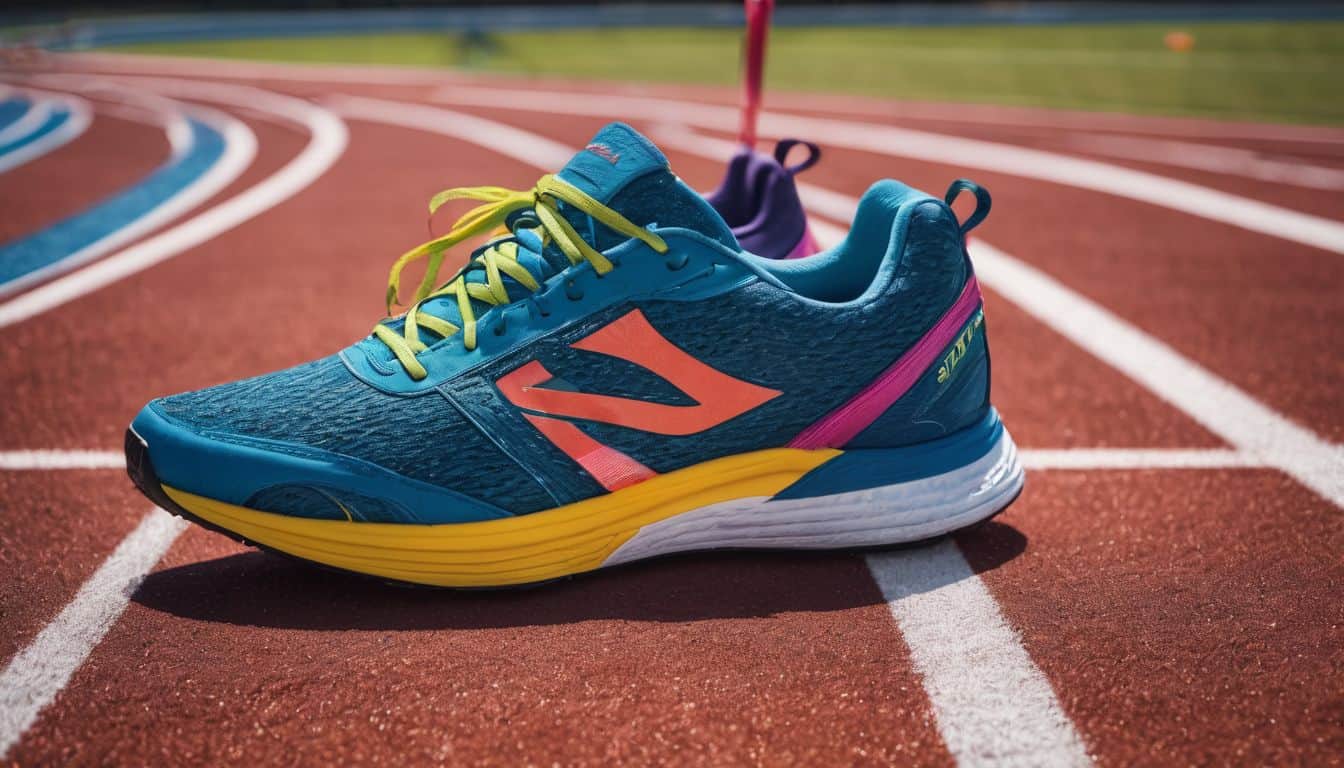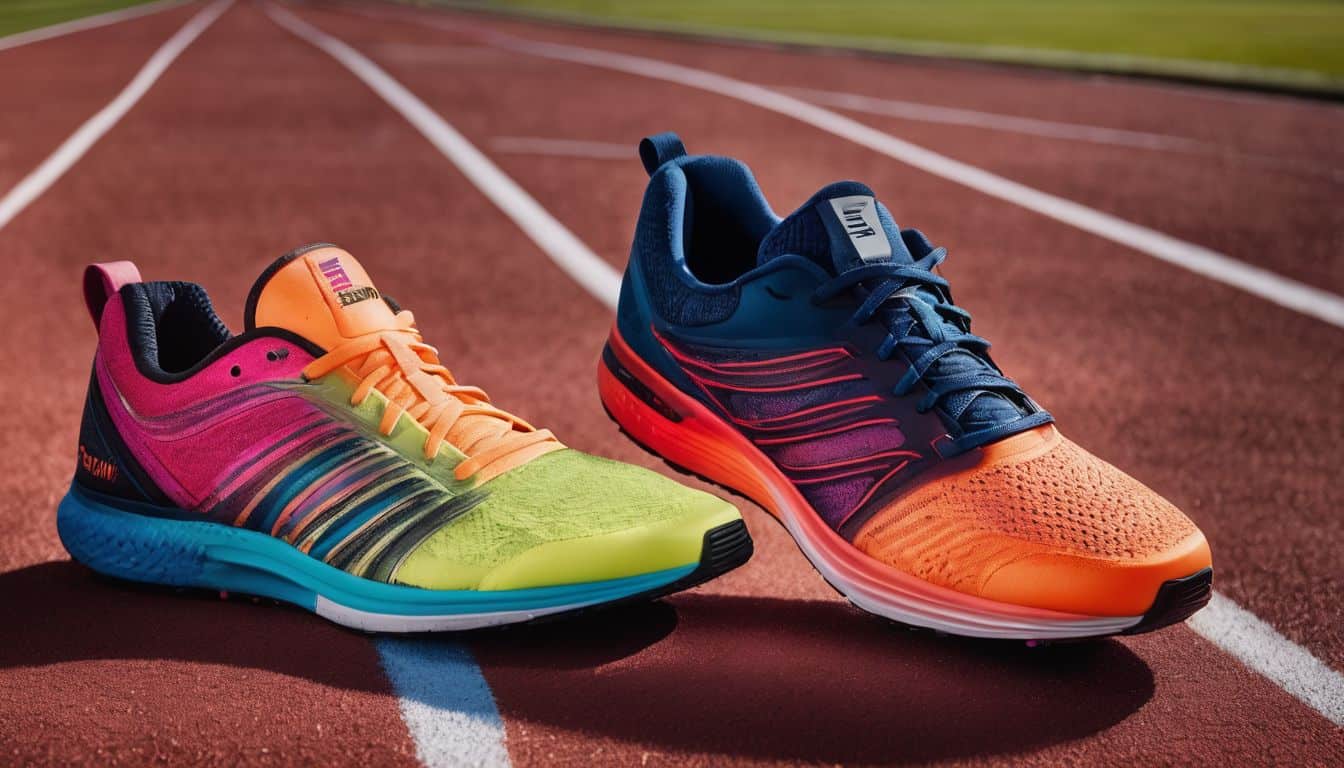Navigating the world of running footwear can feel like stepping into a maze of sneakers, jogging shoes, and training kicks. It’s enough to make your head spin faster than a top-tier treadmill.
Are training shoes even suitable for pavement pounding? Considering that you will likely shell out anywhere from $115 to $120 for a branded pair, it’s essential to lace up with some knowledge before digging into your wallet.
This article is designed to be your roadmap through this puzzling terrain; meticulously analyzing and contrasting running shoes versus their training counterparts, and illuminating their key differences in design and mission.
So grab your water bottle – we’re about to embark on an enlightening trek through all things shoe-related!
Key Takeaways
- Training shoes are different from running shoes and have distinct purposes and designs.
- Training shoes can be used for short distances and low – impact running, but proper running shoes are recommended for longer distances or more challenging terrains.
- Using training shoes for extensive running can lead to decreased performance and increased risk of injuries. It’s important to choose the right footwear based on your specific needs and seek professional advice if needed.
- When choosing the right shoes for running, consider factors such as proper fit and support, individual running style and frequency, and seeking professional advice when necessary.
Differences Between Training Shoes and Running Shoes
Training shoes and running shoes have distinct purposes and designs, with differences in cushioning, support, flexibility, and sole.
Purpose and Design
Training shoes and running shoes are not the same. Training shoes allow you to do a lot of things. You can use them for workouts, gym exercises, and fitness training. They give stability, support, and help you move easily during different types of workouts.
But running shoes have a sole aim – they’re made just for running! So they come with special features that let you run better and keep your feet safe from too much stress. Also, running involves a lot of impact stress as your feet hit the ground time after time.
And because of this, running shoes need more padding than training shoes to absorb this stress.
Cushioning and Support
Training shoes give great cushioning and support. They have a raised design that helps absorb shock. This makes them good for many types of gym workouts. The extra cushion does a fantastic job to help with high-impact exercises.
Running shoes, on the other hand, are lighter and less bulky. They have special foam or gel in the middle part for more springiness when you run. These shoes are built in a way that supports long distance running better than training shoes would do.
Flexibility and Sole
Training shoes are flat on the bottom. This lets you move in many ways. Running shoes bend with your foot as it moves. They make running feel more natural and easy for you. A higher heel can be bad for your knees, but running shoes don’t have these higher heels like other kinds of athletic shoes do.
Can Training Shoes Be Used for Running?

Short Distances and Low Impact
For short distances and low-impact running, training shoes can be used. These shoes are designed to provide support and cushioning for activities like cross-training and gym workouts.
While they may not have all the features of dedicated running shoes, they can still offer enough comfort and protection for shorter runs. It’s important to note that if you’re planning on running longer distances or on more challenging terrains, it’s best to invest in proper running shoes specifically designed for those activities.
But for casual jogging or light runs, training shoes can be a suitable option.
Terrain Considerations
When considering using training shoes for running, it’s important to take into account the type of terrain you’ll be running on. Different terrains require different types of shoes for optimal performance and safety.
For example, if you’re going to be running mainly on roads or pavement, road-running shoes would be more suitable. They provide cushioning and support specifically designed for hard surfaces.
On the other hand, if you plan on trail running or off-road adventures, trail-running shoes are a better choice. These shoes offer enhanced grip and durability to handle uneven terrain and rocky paths.
Comfort and Personal Preference
When it comes to choosing the right shoes for running, comfort and personal preference play a significant role. Shoe comfort is often seen as a protective factor against running-related injuries.
Everyone has different preferences when it comes to the thickness and firmness of the midsoles in their shoes. Some runners prefer more cushioning, while others like a firmer feel.
Research shows that highly cushioned shoes, like HOKA shoes, don’t necessarily reduce the risk of injuries. Ultimately, finding what feels comfortable for you is important in preventing discomfort or pain during your runs.
Risks of Using Training Shoes for Running
Using training shoes for running can lead to decreased performance and increased risk of injuries. Read on to find out why it’s important to choose the right shoes for your runs.
Decreased Performance
Using training shoes for running can lead to decreased performance. When it comes to long-term effects on running, minimalist shoes may negatively affect your performance. Ground reaction forces also vary depending on the type of shoe worn during training, and this can impact how well you run.
Additionally, the mass of your running shoes can affect your foot strike pattern and potentially lead to decreased performance. It is important to choose the right shoes for running that have the appropriate features for your level of running, as this can help prevent injuries and maintain optimal performance.
So, when considering which shoes to wear while running, keep in mind that using training shoes may not be ideal if you want to perform at your best. Remember to consider factors such as cushioning, support, flexibility, and proper fit when selecting your running footwear.
Increased Risk of Injuries
Wearing the wrong type of shoes while running can put you at an increased risk of injuries. This includes wearing training shoes instead of proper running shoes. Shoes that are not designed specifically for running may lack the necessary cushioning, support, and flexibility needed to protect your feet and prevent injuries.
Additionally, wearing inappropriate footwear increases your chances of developing blisters and experiencing shin pain. It’s important to choose the right shoes for running based on factors such as fit, support, and your individual running style.
Seeking professional advice can also help you make the best choice in order to reduce your risk of getting injured while enjoying your runs.
In-depth Analysis: Are Training Shoes Good for Running?
As a running enthusiast, you may be wondering if training shoes are good for running. Well, the answer is not so straightforward. Training shoes and running shoes have some key differences in terms of their purpose and design.
While training shoes are more versatile and suitable for various types of exercises, running shoes are specifically designed to support the forward-to-back motion of running.
When it comes to cushioning and support, running shoes generally provide more shock absorption and stability compared to training shoes. This is important because when you run, your feet experience a lot of impact with each stride.
On the other hand, training shoes tend to be firmer with less cushioning as they prioritize lateral movement during workouts.
The flexibility and sole structure also differ between these two types of footwear. Running shoes typically have a softer sole that allows for better flexibility in the forefoot area.
This helps promote a natural foot motion while reducing strain on your feet and ankles. In contrast, training shoes often have flatter soles that allow for a wider range of movement during gym workouts or cross-training activities.
Considering these factors, training shoes can be used for running in certain situations. They are suitable for shorter distances or low-impact runs where you don’t require as much cushioning or support.
However, if you’re planning to take up regular long-distance running or trail running which involves uneven terrain, investing in proper running shoes would be wise.
It’s important to note that using training shoes for extensive running can come with risks. The lack of adequate cushioning and support may lead to decreased performance or increased risk of injuries such as shin splints or stress fractures over time.
To ensure you choose the right footwear for your specific needs, consider factors like proper fit and support based on your foot type and arch shape. Also think about your individual running style and frequency before making a decision.
Seeking advice from professionals like podiatrists or experienced shoe salespeople who understand the biomechanics of running can also be beneficial.
In conclusion, while training shoes can be used for running in certain situations, it’s important to understand their limitations and potential risks. If you’re serious about running or plan to engage in high-impact activities frequently, investing in a good pair of running shoes specifically designed for running would be your best bet.
Remember to prioritize comfort, fit, and support to keep yourself injury-free and enjoy your runs to the fullest!
Choosing the Right Shoes for Running
When it comes to choosing the right shoes for running, it’s crucial to consider factors such as proper fit and support, your running style and frequency, and seeking professional advice if needed.
Proper Fit and Support
Choosing the right running shoes is essential for a proper fit and support. When it comes to fit, it’s important to find shoes that are slightly larger than your regular size to allow room for comfortable movement.
Your feet should not slip inside the shoes, as this can lead to discomfort and blisters. Arch support is also crucial, especially if you have high or low arches. A shoe with a stable heel counter can provide added stability during runs.
Remember to consider your pronation type and choose a shoe that offers the appropriate amount of control. Lastly, make sure the midsole provides enough responsiveness while still offering cushioning for impact absorption.
Considering Running Style and Frequency
When it comes to choosing the right shoes for running, it’s important to consider your individual running style and frequency. Factors such as your weight, muscular strengths, range of motion, balance, stride habits, efficiency, and speed all play a role in determining what type of shoe will work best for you.
For example, if you have high arches or overpronate when you run (your feet roll inward), you may need a shoe with extra support or stability. On the other hand, if you have neutral arches and a more efficient running gait, a lighter weight and more flexible shoe might be suitable for you.
Consulting with a professional who can analyze your biomechanics can provide valuable insights into selecting the right shoes for your needs. Remember that finding the perfect fit is essential to avoid discomfort and potential injuries while enjoying your runs.
Seeking Professional Advice
When it comes to choosing the right shoes for running, seeking professional advice can be really helpful. Experts can provide personalized recommendations based on your individual requirements and running style.
They can assess your feet accurately, consider factors like pronation and arch support, and give you targeted shoe advice. By consulting a professional, you can ensure that you get the optimal footwear with a customized fit.
So, if you’re unsure about which shoes to choose or if you have specific concerns or requirements, don’t hesitate to seek professional consultation for tailored shoe recommendations.
Conclusion on Are Training Shoes Good For Running
In conclusion, while training shoes can be used for running in certain situations, they are not ideal for long distances or high-impact activities. Running shoes provide better cushioning and support specifically designed for the forward movement of running.
It is important to choose the right shoes based on the activity and seek professional advice if needed.
FAQs on Are Training Shoes Good For Running
1. Can I use training shoes for running?
Yes, you can use training shoes for running as they provide cushioning and support, but it’s important to choose the right pair that provides adequate stability and shock absorption.
2. What is the difference between training shoes and running shoes?
Training shoes are designed for multi-purpose activities like weightlifting, cross-training, and gym workouts, while running shoes are specifically built to provide cushioning, support, and stability for the repetitive impact of running.
3. Are training shoes suitable for long-distance running?
While training shoes can be used for shorter runs or casual jogging, they may not provide enough comfort or support needed for long-distance running. It’s recommended to invest in proper running shoes if you regularly run longer distances.
4. Can I prevent injuries by wearing training shoes while running?
Wearing appropriate footwear like dedicated running shoes can help reduce the risk of injuries that may occur due to inadequate cushioning or improper support provided by training shoes during intense or prolonged runs.
5. Should beginners use training shoes or specialized running sho
es?
Beginners who are new to running should consider using specialized running shoes as they offer better shock absorption and stability tailored specifically for this activity. This will help minimize discomfort and potential foot-related issues during their initial stages of building endurance.






Leave a Reply